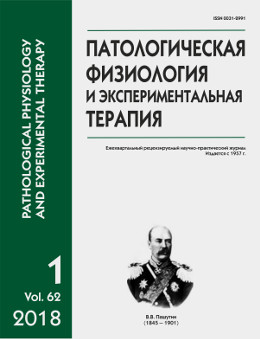Interconnection between the number of ectopic focuses and degree of chaoticity of ventricular fibrillation
Abstract
Electrical activity of a heart in ventricular fibrillation is registered on an electrocardiogram as chaotic alternating different in amplitude and duration of exaltations. For the quantitative analysis of these irregularities methods of mathematical modeling and chaos theory are widely used. The aim of the present investigation is application of mathematical modeling methods for studying interrelation between the degree of chaoticity of ventricular fibrillation and number of the ectopic focuses functioning in a myocardium. Electrical activity of a heart in ventricular fibrillation was modeled as a sum of N independent pulse streams with various amplitude-frequency and phase characteristics. Degree of chaoticity of electrical activity of a heart was estimated by entropy and phase portraits of fibrillar oscillations. Theoretical dependences between degree of chaoticity of ventricular fibrillation and number of pulse streams were calculated by computer modeling. Results of computer experiments were compared with those of real physiological experiments on rats and dogs. It was shown that degree of chaoticity of fibrillar oscillations is different in rats and dogs and depends on the number of the ectopic focuses functioning in a myocardium. For rats two-focal types of models of ventricular fibrillation were characteristic, for dogs - multifocal (4-5 focuses) types.
Downloads
References
2. Ganesan A.N., Kuklik P., Gharaviri A., Brooks A., Chapman D., Lau D.H. et al. Origin and characteristics of high Shannon entropy at the pivot of locally stable rotors: insights from computational simulation. PLoS One. 2014; 9(11): e110662.
3. Mysiak A., Kobusiak-Prokopowicz M., Kaaz K., Jarczewska K., Glabisz W. Characteristics of chaotic processes in electrocardiographically identified ventricular arrhythmia. Cardiol J. 2017; 24(2): 151-8.
4. St-Yves G., Davidsen J. Influence of the medium's dimensionality on defect-mediated turbulence. Phys Rev E Stat Nonlin Soft Matter Phys. 2015; 91(3):032926.
5. Qu Z. Chaos in the genesis and maintenance of cardiac arrhythmias. Prog Biophys Mol Biol. 2011; 105(3): 247-57.
6. Mezentseva L.V, Kaschtanov S.I, Vostricov V.A, Zviagintseva M.A., Koscharskaia I.L. Analysis of ECG in ventricular fibrillation in mans and animals based on chaos theory. Biofizika. 2002; 47(2): 352-59.
7. Panescu D., Kroll M., Brave M. Limitations of animal electrical cardiac safety models. Conf Proc IEEE Eng Med Biol Soc. 2014; 6483-6.
8. Maruyama T, Sakaguchi H. Spiral chaos, ventricular fibrillation and defibrillation: simulation study toward painless defibrillation. Fukuoka Igaku Zasshi. 2014; 105(6): 131-8.
9. Pravdin S.F., Dierckx H., Katsnelson L.B., Solovyova O., Markhasin V.S., Panfilov A.V. Electrical wave propagation in an anisotropic model of the left ventricle based on analytical description of cardiac architecture. PLoS One. 2014; 9(5):e93617.
10. Vandersickel N., Kazbanov I.V., Defauw A., Pijnappels D.A., Panfilov A.V. Decreased repolarization reserve increases defibrillation threshold by favoring early after depolarizations in an in silico model of human ventricular tissue. Heart Rhythm. 2015; 12(5): 1088-96.
11. Zheng Y., Wei D., Zhu X., Chen W., Fukuda K., Shimokawa H. Ventricular fibrillation mechanisms and cardiac restitutions: An investigation by simulation study on whole-heart model. Comput Biol Med. 2015; 261-8.
12. Mezentseva L.V. Computer Modeling of Ventricular Fibrillation. Biophysics. 2012; 57(2): 247-52.
13. Mezentseva L.V. Program MODVF – Mathematical Modeling of Ventricular Fibrillation. The certificate on the state registration of the computer program № 2011610618. 23.03. 2011.
14. Strutynskiy A.V., Glazunov A.B., Cygankov E.V., Banzelyuk E.N., Kallaeva A.N. Capabilities of revealing myocardium electrical inhomogenity in patients with ventricular arrhythmias at multipole superficial ECG-mapping of the heart Mezhdunarodnyy meditsinskiy zhurnal. 2004; 2: 17-21. (in Russian)
15. Kuz'min V.S., Rozenshtrauh L.V. Excitation Conduction in the Rat Pulmonary Veins Myocardium assessed by the optical mapping. Rossiyskiy fiziologicheskiy zhurnal im. I.M. Sechenova. 2012; 98; 9: 1119-30. (in Russian)
16. Revishvili A.Sh., Rzaev F.G., Dzhetybaeva S.K. Electrophysiological diagnostics and catheter treatment of complex cardiac arrhythmias with the use of three-dimensional electro-anatomical mapping. Vestnik Aritmologii. 2004; 34: 32-7. (in Russian)
17. Germanova O.A., Germanov A.V., Kryukov N.N., Germanova I.K., Borzenkova G.A. Functional classification of extrasystoles. Materialy VII Vserossiyskogo sezda aritmologov Moscow, 1-3 june 2017. Moscow; 2017: 12-3. (in Russian)
18. Park S.A., Gray R.A. Optical Mapping of Ventricular Fibrillation Dynamics. Adv Exp Med Biol. 2015; 859: 313-42.
19. Behradfar E., Nygren A., Vigmond E.J. The role of Purkinje-myocardial coupling during ventricular arrhythmia: a modeling study. PLoS One. 2014; 9(2):e88000.
20. Jalife J.1. Spatial and temporal organization in ventricular fibrillation. Trends Cardiovasc Med. 1999 Jul; 9(5): 119-27.






